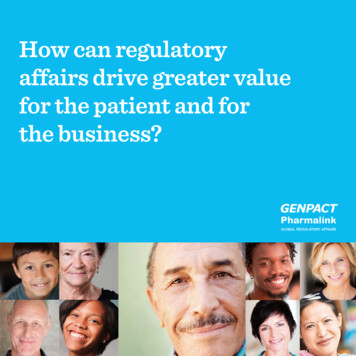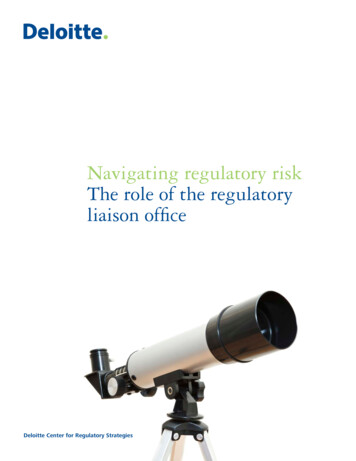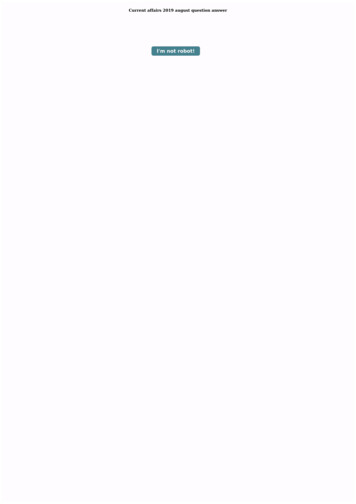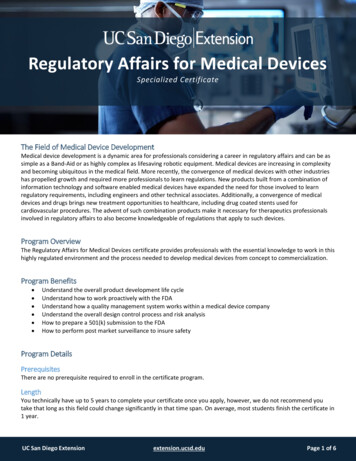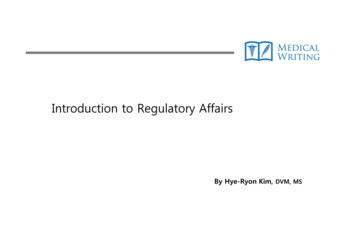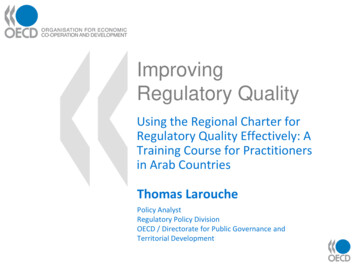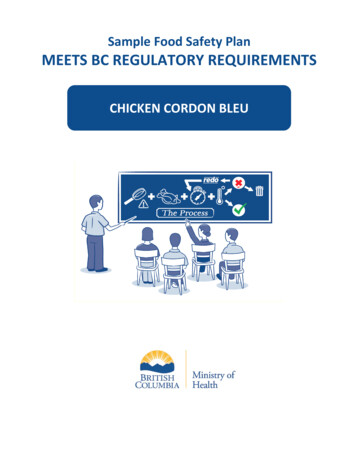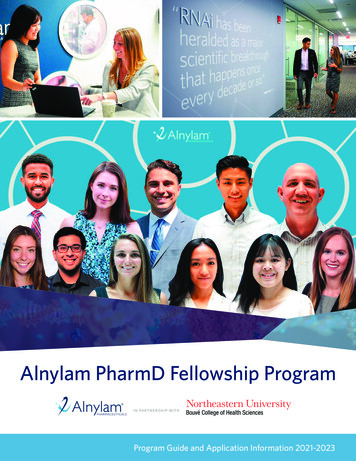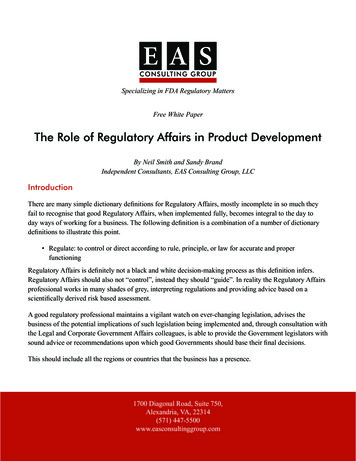
Transcription
Specializing in FDA Regulatory MattersFree White PaperThe Role of Regulatory Affairs in Product DevelopmentBy Neil Smith and Sandy BrandIndependent Consultants, EAS Consulting Group, LLCIntroductionThere are many simple dictionary definitions for Regulatory Affairs, mostly incomplete in so much theyfail to recognise that good Regulatory Affairs, when implemented fully, becomes integral to the day today ways of working for a business. The following definition is a combination of a number of dictionarydefinitions to illustrate this point. Regulate: to control or direct according to rule, principle, or law for accurate and properfunctioningRegulatory Affairs is definitely not a black and white decision-making process as this definition infers.Regulatory Affairs should also not “control”, instead they should “guide”. In reality the Regulatory Affairsprofessional works in many shades of grey, interpreting regulations and providing advice based on ascientifically derived risk based assessment.A good regulatory professional maintains a vigilant watch on ever-changing legislation, advises thebusiness of the potential implications of such legislation being implemented and, through consultation withthe Legal and Corporate Government Affairs colleagues, is able to provide the Government legislators withsound advice or recommendations upon which good Governments should base their final decisions.This should include all the regions or countries that the business has a presence.1700 Diagonal Road, Suite 750,Alexandria, VA, 22314(571) 447-5500www.easconsultinggroup.com
Proactive Regulatory Affairs professionals should also provide strategic and technicaladvice to all levels of the business and at all stages of the product cycle from ideationor concept discussions through to commercialisation, and beyond.Specializing in FDARegulatory Matters1700 Diagonal RoadSuite 750Alexandria, VA, 22314(571) 447-5500easconsultinggroup.comConversely, proactive engagement with Regulatory Affairs by all levels within thebusiness ensures decision making is consistent, timely, and accounts for all factors,resulting in a considerably reduced launch time for any new product.This paper identifies where good Regulatory Affairs can make a significant impact on:Regulatory Affairs “Best Practice”Before we delve into how Regulatory Affairs should be integrated into the ProductDevelopment process, it is appropriate that we clearly identify what good RegulatoryAffairs should look like.Most large companies will have a dedicated team of professionals in a “RegulatoryAffairs” department with a clear career path from a junior Regulatory Analyst throughto the Regulatory Affairs Manager or Director, depending on the size and scope of thebusiness.The term “Best Practice” means “a method or technique that has been generallyaccepted as superior to any alternatives because it produces results that aresuperior to those achieved by other means or because it has become a standardway of doing things”Unfortunately, smaller and medium sized companies are usually forced to merge orcombine roles resulting in there being no dedicated Regulatory Affairs functions andthis often results in the Regulatory component of the business requirements beingincomplete or inaccurate. Product Developers or QA practitioners usually “doublehat” and include Regulatory Affairs responsibilities and often this leads to a conflict ofinterest with their primary activities.The following is a model for Regulatory Affairs “Best Practice” that was successfullydeveloped and adopted for the global Regulatory Affairs team of a major corporation.It illustrates the successive incremental increases in Regulatory activities as anorganization matures.November 2, 2017Page 2
nfluencerLeadership/ISpecializing in FDARegulatory Mattersperational1700 Diagonal RoadSuite 750Alexandria, VA, 22314(571) zon ScanningAgreed PrioritiesAgreed Business PositionsNetwork of Key ContactsLegislative Change ControlCommunication of Legislative ChangesProactive Regulatory Input Into InnovationPolicies and Procedures for Key IssuesBasic/FoundationThe Following Must Comply with LegistationProduct Formulation, Ingredients and PackagingFactories and Manufacturing ProcessesStatutory Label DeclarationsClaims (On-Pack and Off-Pack)Nutritions DeclarationAllergen and Other WarningsBasics – Foundation of PyramidThis is the day to day work that would usually encompass approximately 60% of theRegulatory Affairs department’s workload conducted generally by Regulatory Analystsor those developing the base skills in Regulatory Affairs, with the key focus being to: Ensure that Product Specifications conform to legislation Ensure that ingredients and packaging materials conform to legislation Ensure that the statutory declarations on labels conform to legislation Ensure that claims on the label are not misleading and are linked to thestatutory declarations requirements or standards and are included in claimstables where relevant Ensure nutrition declarations can be validated by either calculation fromrecipe or analysisNovember 2, 2017Page 3
Ensure that allergen cross-contamination risks identified by the HACCP’sgenerate appropriate allergen warnings on labels, and that changes arehighlighted adequately for ConsumersSpecializing in FDARegulatory Matters1700 Diagonal RoadSuite 750Alexandria, VA, 22314(571) 447-5500easconsultinggroup.com Measure and maintain levels of performance with the aim of “getting itright the first time”Note that the key word is ENSURE and not DO, meaning that Regulatory Affairsshould be conducting the final review and sign off and not necessarily completing allthe tasks that lead up to the final review. In many cases if Regulatory Affairs were to bedoing all the work and also the final review and sign off it would be a clear conflict ofinterest. Those responsible for QA and R&D functions should be aiming to “get it rightthe first time” and as such are ultimately responsible for DOING this work as part oftheir day to day role.Value/Operational – Middle Layer of PyramidThis is the role that a middle or upper level Regulatory Affairs Manager / Supervisorwould be responsible for. It would usually encompass approximately 30% of theRegulatory Affairs department’s workload with the focus being on building internaland external relationships and partnerships based on the company’s embedded strategicbusiness direction and ensuring the appropriate policies and guidelines are established.The focus being on: Creative and proactive regulatory input into the innovation process,partnering with Commercial, R&D and Legal) Collaborating with R&D to evaluate new manufacturing processes,ingredients and packaging against legislation, and legislation changes Ensure compliance with nutrition and health claims in collaboration withCommercial, R&D, Legal and Nutrition Clear and specific communication of new and changed legislativerequirements to the relevant parts of the business – including follow-upto ensure that effective action has been taken. This is a collaboration withR&D, Legal, Supply Chain, Corporate Government Affairs Routine policies and procedures (such as product claims, documentation,specifications) are established and embedded in collaboration with SupplyChain, Legal, Corporate Government Affairs and R&DNovember 2, 2017Page 4 Policies regarding sensitive issues (such as GMOs, irradiation, and useof artificial or natural ingredients) are established and embedded incollaboration with Legal, Corporate Government Affairs and R&D
Leadership/Influencer – Top of PyramidSpecializing in FDARegulatory Matters1700 Diagonal RoadSuite 750Alexandria, VA, 22314(571) 447-5500easconsultinggroup.comWhile the base and middle sections of the pyramid are essentially upward looking,those activities at the top of the pyramid are downward looking. These are muchwider thinking aspects to the Regulatory Affairs department’s responsibilities and aregenerally the responsibility of the Senior Regulatory Affairs Manager or RegulatoryAffairs Director, accounting for a very critical 10% of the departments activities.These activities are definitely those where collaboration between Legal and CorporateGovernment Affairs is mandatory. “Horizon scanning” to identify regulatory issues that represent a potentialthreat or opportunity to the business. Senior business management is tobe briefed on the potential business impact of these issues, taking intoaccount the competitive environment and the positions of government,NGOs, pressure groups, media, etc Responding directly to Government on behalf of the company on issuesrelating to changes in Regulations that affect the business Business-agreed list of influencing priorities and objectives, with namedissue-owners, including business position statements on the influencingpriorities and other key issues Network of Trade Association contacts and committees plus scientificcontacts where issues can be addressed back to Government Be aware of, and seek to adopt international guidelines when appropriateThe scope of Regulatory Affair’s role in the Leadership or Influencer area of thepyramid will be determined by the business objectives and the need to change theregulatory environment in order to meet long term sustainability. Most small tomedium sized companies do not operate in this area of the best practice pyramidand while this may mean they are unable to proactively engage with Government orNGO’s, being engaged with significant Trade Associations may allow them to at leastkeep up to date with emerging issues, including relevant changes to legislation.There is little or no value in seeking changes to regulations where the business doesnot have a strategy in place to participate.November 2, 2017Page 5Where small and medium sized businesses may benefit is through the use ofRegulatory Affairs consultancies where a proactive participation in Trade Associationsand Government activities allows them to monitor changes to regulations on behalfof many businesses. However, it should be noted that in some parts of the world, theConsultancy may not be able to join major Trade Association, or officially act onbehalf of the business in Trade Association activities.
Good Regulatory Affairs must be a proactive role – it cannot be a reactive oneotherwise it becomes a “rubber stamp” role to the practices and procedures that thebusiness has already implemented.Specializing in FDARegulatory Matters1700 Diagonal RoadSuite 750Alexandria, VA, 22314(571) 447-5500easconsultinggroup.comRegulatory Affairs achieves this by: Proactively engaging with Trade Associations, Government and NGO’s toensure that businesses not only are kept aware of changes in legislation,but have the ability to influence legislation changes to maximiseopportunities to the business Proactively maintaining a watching brief on Regulatory, Scientific andNutrition issues and ensuring the business is aware of impending changesor challenges and the risks associated with them Proactively engaging with our internal stakeholders and partners such asCorporate Affairs, Legal, and Commercial Building a sound knowledge base within RD&Q to assist thoseresponsible for developing and approving our products Creating appropriate procedures and providing training to ensure there isa complete understanding of compliance requirements. This essentiallymakes the R&D more attuned to any legislative requirements, leading to“smarter” product development Proactively engaging with like-minded colleagues across the globe toensure an understanding exists related to changes in legislation elsewherein the world and the potential impact these changes may have on ourdomestic business, as well as potential export markets Proactively engaging in the Stage & Gate process to provide businessdirection in the product development processRegulatory Affairs should be a focus point for Government agencies as theyrespond better to companies whose representatives are scientifically accurate andknowledgeable of pertinent regulations. Government agencies, NGO’s and TradeAssociations actively seek out comment from those businesses who, through goodRegulatory Affairs, can provide scientifically sound knowledge of appropriatelegislation.Stage & Gate process for Product DevelopmentNovember 2, 2017Page 6Most businesses operate a stage & gate process, either informally or formally, toprogress projects or developments to finalization. The stage & gate process is aproject management technique in which any project, business improvement initiativeis managed in stages. In between each stage there is a gate where the business
Specializing in FDARegulatory Matters1700 Diagonal RoadSuite 750Alexandria, VA, 22314(571) 447-5500easconsultinggroup.commanagement (or the project management committee) is required to make decisions,based on the all the information available at that time. This could include the businesscase, risk analysis, resources, and financial measures. In reality, the project shouldnot proceed to the next stage unless all the necessary information is available for thebusiness management to make a full and complete assessment.However, many small to medium sized businesses don’t have a formal process per se,but will recognise the stages described in below.The role of Regulatory Affairs is such that they touch each and every product, ensuringcompliance with local regulations and internal policies and guidelines relating to foodlabelling, safety and nutrition, and therefore must be considered as an integral part ofthe stage & gate process.Regulatory Affairs is more than just ensuring compliance with Labelling regulations.Through the strategic links to trade associations, Government agencies, and NGO’s thebusiness is kept abreast of all changes in regulations that may affect the business, aswell as key development in food and nutrition science, based upon which they are ableto provide direction on the product development process so that the business achievesthe best outcome for the business.Note that a role for the Regulatory Affairs Manager or Director is to be able toinfluence changes to Government legislation and policy, should this be required to gaina market advantage.While there are many variations on the Stage & Gate process in its most simple formthere should always be the following stages.1.Idea Development – a feasibility review defining the project2.Project Development, Design, Testing, and Validation3.Execution or Project Launch or Commercialisation4.Project Evaluation post LaunchStage 2 could be split so that the Testing and Validation processes become the nextstage.November 2, 2017Page 7Stages 1 through 3 are generally recognized as being “standard practice” andbusinesses believe that they do these stages well, implementing the appropriatemeasures (financial, political, sales volumes, etc.) that need to be met in order to passthrough the “gates” as the project progresses. In the ideal world, sub-standard projectswould be rejected should the measures not be met. This is essentially the deciding roleof the “gate keepers”.
However, many businesses neglect to conduct the Project Evaluation. This is generallydone 3-6 months after the project has been finalized and the success, or failure of theproject can be measured.Specializing in FDARegulatory Matters1700 Diagonal RoadSuite 750Alexandria, VA, 22314(571) 447-5500easconsultinggroup.comThe following identifies the roles and responsibility of Regulatory Affairs in thevarious phases of the Stage & Gate Product Development processIdea DevelopmentThis is a stage where Regulatory Affairs are often neglected yet they have a criticalrole to play. Regulatory guidance at the onset of any project often dictates the directionthe project can or cannot take.Engagement at the Idea Development stage: Regulatory Affairs can provide guidance on claims, either implicit orinferred, on proposed labels / packaging or in the media. Compliance to internal policies and guidelines By reviewing the proposed formula, guidance can be provided as to howmodifying the formulation may permit additional claims to be made orstrengthen current claims Allows Regulatory to collaborate with Commercial on positioning ofclaims, including reviewing competitor products Regulatory can advise on specific impending changes to legislation thatmay impact the project If there is a desire to use a formulation or ingredients that are currentlynon-compliant, Regulatory Affairs may to need lodge appropriateapplications with Government agencies. This may especially be importantwhere a business has access to a new technology or a new / novelingredient and gaining access to the market provides a critical “first tomarket” advantage. Applications to Government to change legislationare often costly and may take a considerable amount of time to realize.Initiating this as soon as possible once the “Idea Development” stage hasbeen passed could save a considerable amount of time in the developmentcycle. Note that is not a cost that should be borne by Regulatory Affairs. Itis a cost of “doing business” and it should be identified in the overall costof the project.November 2, 2017Page 8
Project Development, Design, Testing, and ValidationSpecializing in FDARegulatory Matters1700 Diagonal RoadSuite 750Alexandria, VA, 22314(571) 447-5500easconsultinggroup.comAt this stage, Regulatory Affairs finalizes assessment of any risks and constraints of thefinal formulation and works in close collaboration with R&D to: Build dossier of data required to substantiate any claims, ensuring that allclaims are firstly validated and there are processes in place to ensure thatall claims will continue to be valid. Review and approve specifications developed by R&D, including Raw Materials Formulations Final Product Contribute to the labelling design brief by creating (which may be incollaboration with R&D) sections of the mandatory label text, including Nutrition Information Panel Ingredients List Product claims Allergen declarations Develop any new internal policies and guidelines ensuring that they arenot only clear and concise, but offer flexibility based on a risk assessment.Use real life examples to provide clarity.Regulatory Affairs should maintain active engagement with R&D and Commercialareas of the business during this stage so they are aware of any issues that have arisenduring product development. This could include “minor tweaks” to the formula orchanges to components, which were unforeseen or forced by process constraints.Regulatory Affairs should ensure that their original recommendations or advice is stillvalid and offer the appropriate recommendations to ensure the project stays on track.Execution or Project Launch or CommercialisationBy now all responsibilities identified in the Project Development & Design stage willhave been finalized.November 2, 2017Page 9At this stage, the product is about to be manufactured for the first time, but beforethis, the label artwork will need to be created and approved prior to packaging beingcreated. Regulatory Affairs should not be the only function to sight and approveartwork, hence the need for a structured approach to the approval process, includingagreed time frames. Do not underestimate the benefits that a structured artwork
governance can bring to ensuring artwork is developed and approved in a timely andcost effective manner.Specializing in FDARegulatory Matters1700 Diagonal RoadSuite 750Alexandria, VA, 22314(571) 447-5500easconsultinggroup.comIdeally there should be a RACI* created so there are clear lines of responsibilityfor sections of the artwork. Commercial, R&D, Packaging, and Legal should all beincluded with Regulatory Affairs and Legal sighting the artwork after Commercial andR&D. This allows Regulatory Affairs to identify where there are gaps in the approvalprocess and where additional training may be required.*(RACI stands for: Responsible – Who is completing the task, Accountable – Who is making decisionsand taking actions on the task(s), Consulted – Who will be communicated with regarding decisions andtasks and Informed – Who will be updated on decisions and actions during the project.)For Regulatory Affairs, at this stage there should be a minimal amount of input,assuming there has been full engagement in the first 2 stages.Project EvaluationThis is a stage that is often ignored or forgotten yet it is very critical in ensuringthat mistakes or errors made during the process are clearly identified and mitigatingprocedures are initiated to ensure they don’t reoccur. Importantly it should also be anopportunity to celebrate success.The decisions, recommendations or advice that Regulatory Affairs provided during thecourse of the project should also come under review. It is also a trigger for RegulatoryAffairs to review guidelines and processes to ensure they are still valid.In conclusion, Regulatory Affairs professionals should proactively engage and providestrategic and technical advice to all levels of the business to ensures decision-makingincorporates regulatory factors that directly impact product launch strategy.About EAS Consulting Group, LLCNovember 2, 2017Page 10EAS Consulting Group, LLC (EAS) specializes in US Food and Drug Administration(FDA), state and local governmental regulatory matters. Our prime focus is to assistdomestic and foreign food, infant formula, pharmaceutical, medical device, tobacco,dietary supplement, and cosmetic firms comply with applicable laws and regulations.EAS is staffed with former FDA and state compliance and inspection officials, andis assisted by an extensive network of over 150 consultants with many years of FDAand industry experience. EAS has organized its independent consultants into Teamsto address multi-dimensional, multi-faceted client projects including all aspects ofproduct development.
Specializing in FDARegulatory Matters1700 Diagonal RoadSuite 750Alexandria, VA, 22314(571) 447-5500easconsultinggroup.comNovember 2, 2017Page 11Headquartered in Alexandria, VA with consultants and auditors located strategicallythroughout the U.S. and in various foreign countries, EAS Consulting Group wasestablished as an independent company in October 2006. The company’s roots goback nearly a half century to 1960 when Arthur A. Checchi, former FDA AssociateCommissioner, founded the company. In 1985 FDA’s Director of Regional Operations,Anthony C. Celeste, assumed the leadership of the company. He operated it under thename AAC Consulting Group (AAC). In 2001 the company was acquired by KendleInternational, one of the world’s largest global clinical research organizations. In2006 Mr. Edward Steele, then President of AAC and Vice President of the company’sRegulatory Affairs Division, acquired the Division of Food, Dietary Supplement,and Cosmetic Consulting from Kendle and formed EAS Consulting Group as anindependent company. Since September 2007, pharmaceutical, medical device,tobacco, meats and EPA-based consulting categories have been added to the list ofservices offered by EAS.
wider thinking aspects to the Regulatory Affairs department's responsibilities and are generally the responsibility of the Senior Regulatory Affairs Manager or Regulatory Affairs Director, accounting for a very critical 10% of the departments activities. These activities are definitely those where collaboration between Legal and Corporate


